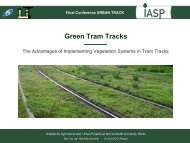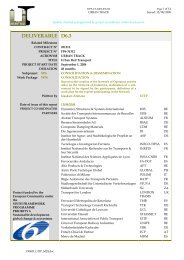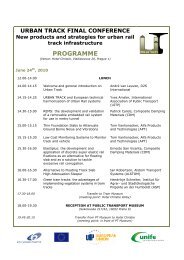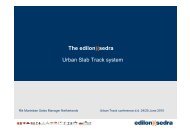DELIVERABLE 2.8 - urban track
DELIVERABLE 2.8 - urban track
DELIVERABLE 2.8 - urban track
You also want an ePaper? Increase the reach of your titles
YUMPU automatically turns print PDFs into web optimized ePapers that Google loves.
<strong>2.8</strong>. FRANKFURT<br />
D0208_STIB_M24.doc<br />
TIP5-CT-2006-031312 Page 20 of 44<br />
URBAN TRACK Issued: August 13, 2008<br />
Quality checked and approved by project co-ordinator André Van Leuven<br />
VGF (Frankfurt) operates 300 km of <strong>track</strong> with a 50/50 split between grooved and vignol rail. The<br />
introduction in 1995 of the low floor vehicles caused the same problems as in Bremen. VGF uses the<br />
following tools:<br />
One lubrication vehicle;<br />
Stationary lubrication systems (which cause problems during welding);<br />
Resilient wheels on vehicles operating in the city.<br />
Since 1988 they use the same welding technique as in Brussels on rails with low carbon content.<br />
They use Riflex (Electrothermit) of 1700 N/m with Q800 on the top of the rail to combat corrugation and<br />
ETEKA 5 of 1400 N/m on the side of the rail to combat wear. The problem is the splitting off of the weld<br />
under the vertical wheel load. The Riflex was ground away and the rails finished with Citorail (= DUR<br />
300).<br />
This technique had the following problems:<br />
The rails are not machined for the pre-emptive welding, but grooves are burned out. Therefore the<br />
rails have to be carefully cleaned. Otherwise, the welds easily break out of the rail head.<br />
The material characteristics change during the heating process (e.g. rail welding). This produces a<br />
surface with inconsistent properties that results in weak spots (20 cm each side of the weld) and<br />
variations in the rail height.<br />
The material easily breaks away from the rail head and requires frequent weld repairs and frequent<br />
grinding after the repairs.<br />
The method requires a lot of attention and is very costly.<br />
In 1998 they worked with perlitic vignol rail with Q1100 on the outer rail and Q880 on the inner rail.<br />
Grooved head hardened rail had to be removed after the welding of the lip which caused the lip to break-<br />
off. Currently they use Ri59 and Ri60 of Q700.<br />
The rails are installed as delivered and wear reaches 7 mm after only 6 months. Wear increases both on<br />
the head and on the lip and reaches 12 to 15 mm after 14 months. They use the same welding material as<br />
in Bremen. UGF also has flange lubrication installed on 20 vehicles.<br />
The cost of rail replacement is 1400€ per m; build-up welding 80€ per m and normal rail welding 80€ per<br />
weld.








